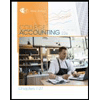
(a) (1)
Accounts receivable turnover is a liquidity measure of accounts receivable in times, which is calculated by dividing the net credit sales by the average amount of net accounts receivables. In simple, it indicates the number of times the average amount of net accounts receivables collected during a particular period.
Average collection period:
Average collection period indicates the number of days taken by a business to collect its outstanding amount of accounts receivable on an average.
To calculate: The accounts receivable turnover of Company A and Incorporation WM for 2014.
(a) (2)
To calculate: The average collection period of Company A and Incorporation WM for 2014.
(b)
To conclude: The Efficiency of management in handling accounts receivable.
Want to see the full answer?
Check out a sample textbook solution
Chapter 8 Solutions
FINANCIAL ACCOUNTING
- financial accountingarrow_forwardA copy machine cost $78,000 when new and has accumulated depreciation of $72,000. Suppose Print and Photo Center sold the machine for $6,000. What is the result of this disposal transaction? Nonearrow_forwardWhat was regal enterprises average collection period?arrow_forward
- How many time par year does the company turn over its accounts receivable?arrow_forwardThe following information is taken from the financial statements of a company for the current year: Current assets $ 3,95,000 Total assets $ 8,90,000 Cost of goods sold $ 6,50,000 Gross profit $ 2,00,000 $ 1,20,000 Net income The gross profit percentage for the current year: A. 24% B. 31% C. 76% D. 60%.arrow_forwardZeel Corporation has an inventory period of 48 days, an accounts receivable period of 8 days, and an accounts payable period of 5 days. The company's annual sales are $195,620. How many times per year does the company turn over its accounts receivable?arrow_forward
- Principles of Accounting Volume 1AccountingISBN:9781947172685Author:OpenStaxPublisher:OpenStax College
 Financial Accounting: The Impact on Decision Make...AccountingISBN:9781305654174Author:Gary A. Porter, Curtis L. NortonPublisher:Cengage Learning
Financial Accounting: The Impact on Decision Make...AccountingISBN:9781305654174Author:Gary A. Porter, Curtis L. NortonPublisher:Cengage Learning Financial AccountingAccountingISBN:9781337272124Author:Carl Warren, James M. Reeve, Jonathan DuchacPublisher:Cengage Learning
Financial AccountingAccountingISBN:9781337272124Author:Carl Warren, James M. Reeve, Jonathan DuchacPublisher:Cengage Learning  Financial AccountingAccountingISBN:9781305088436Author:Carl Warren, Jim Reeve, Jonathan DuchacPublisher:Cengage Learning
Financial AccountingAccountingISBN:9781305088436Author:Carl Warren, Jim Reeve, Jonathan DuchacPublisher:Cengage Learning College Accounting, Chapters 1-27AccountingISBN:9781337794756Author:HEINTZ, James A.Publisher:Cengage Learning,
College Accounting, Chapters 1-27AccountingISBN:9781337794756Author:HEINTZ, James A.Publisher:Cengage Learning, College Accounting, Chapters 1-27 (New in Account...AccountingISBN:9781305666160Author:James A. Heintz, Robert W. ParryPublisher:Cengage Learning
College Accounting, Chapters 1-27 (New in Account...AccountingISBN:9781305666160Author:James A. Heintz, Robert W. ParryPublisher:Cengage Learning





